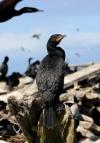 Colony Connectivity of Pacific Coast Double-crested Cormorants
Colony Connectivity of Pacific Coast Double-crested Cormorants
To reduce conflicts with fish resources, other colonial waterbirds, and damage to habitats, double-crested cormorants (Phalacrocorax auritus) are currently controlled (lethally and non-lethally) throughout much of their range. Concerns are growing over the Pacific Coast's largest double-crested cormorant colony at East Sand Island (ESI), Oregon near the mouth of the Columbia River, where cormorants forage on juvenile salmonids, many of which are listed under the United States Endangered Species Act. Management of this colony is currently under consideration and may call for a redistribution of a portion of this colony numbering more than 12,000 breeding pairs in 2009. We investigated regional and site-specific connectivity of ESI cormorants using satellite-telemetry to track post-breeding dispersal. Cormorants dispersed widely west of the Cascade-Sierra Nevada Mountains from British Columbia, Canada to northern Mexico. Tracking data demonstrated direct connectivity between the double-crested cormorant colony at ESI and nesting sites throughout the dispersal area. Results of this study indicate that some cormorants from ESI could disperse to prospect for nesting sites throughout much of the western portion of the range of the Western Population; however, regional variation in connectivity with the ESI population, distance from ESI, and site-specific nesting history will likely result in variable prospecting rates among regions and sub-regions. Management efforts aimed at redistributing ESI cormorants across western North America (e.g., social attraction or dissuasion techniques) might be best allocated to areas or sites known to be used by tagged cormorants, particularly those sites with an established nesting history.
-Karen Courtot (OSU) and 5 co-authors
Click here to view the complete manuscript



